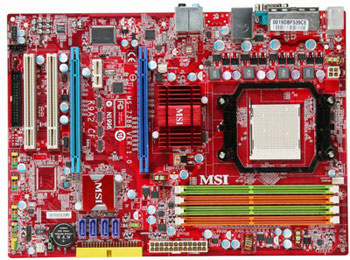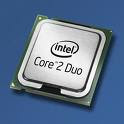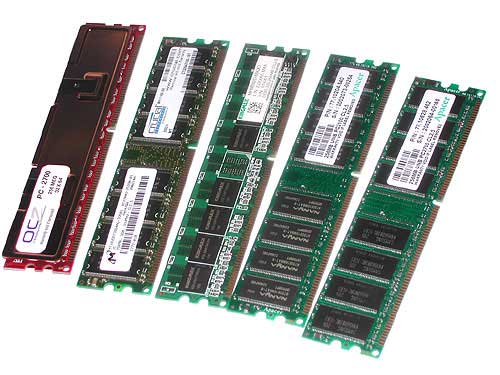the K9A2 CF Motherboard - AMD 790X Chipset
MSI has just announced two new AM2+ motherboards, the value-oriented K9A2 CF and the high-end K9A2 Platinum. The K9A2 CF motherboard will be all most people need as it supports two card Crossfire and the latest quad-core Phenom processors.Check out the layout of the K9A2 below!

MSI’s latest K9A2 CF utilizes the latest AMD 790X chipset, supporting the new generation Socket AM2+ with dual channel DDR2 800 and enables users to overclock to higher level. In addition to being the most future-proof platform currently available, the K9A2 CF is ready to support features such as the new Quad Core Phenom processors which comes with HyperTransport 3.0, a great improvement in the chipset/CPU internal bandwidth, MSI unique technology Dual CoreCell™ with software control Dual CoreCenter, Dual VGA CrossFire, HD 7.1 channel Sound for better mainstream design!
Processors
So what's the big deal with these latest Intel Core 2 Duo processors, anyway? Well, the Merom chips introduced today take the higher power and efficiency of the desktop Core 2 Duo processors introduced a few weeks back and apply that to laptops. Intel claimed the Merom Core 2 Duo processors would show a 20% performance boost over their predecessors, the Core Duo processors used in notebooks.

But we're not going to believe Intel, are we? Trusty testers at Laptop Magazine checked out Intel's claims and it turns out the chip giant's boasts were accurate, even conservative in some cases. The testers used two identical notebooks, where the only difference was one of them had the fastest Core 2 Duo processor and the other had the fastest Core Duo processor. Sure enough, the new Core 2 Duo processor was 22% faster than the old Core Duo, while battery life was still pretty much the same. The newer processor did even better in multitasking operations.
MEMORYDDR memory, PC2100 (DDR266), PC2700 (DDR333), PC3200 (DDR400), PC4200 (DDR533). A quick look at DDR memory, what is DDR memory ? what some of the terms mean & which DDR memory to buy?
What is DDR Memory?
DDR memory is the latest in high-performance memory module technological advances. It offers twice the data bandwidth of conventional PC100 or PC133 SDRAM, and is particularly well suited for high-performance servers and workstations, which need optimal CPU-memory performance. Double Data Rate (DDR) SDRAM (AKA SDRAMII) is precisely what the name implies. A clock cycle can be represented as a square wave, with the rising edge defined as the transition from "0" to "1", and the falling edge as "1" to "0". In SDRAM, only one of these wave edges is used, but DDR SDRAM references both, effectively doubling the rate of data transmission. Unlike 168-pin SDRAM, DDR SDRAM utilizes a 184-pin plug. Although the basic motherboard technology does not need to be changed, DDR SDRAM is not backward compatible on motherboards designed for SDRAM.
Compaq Computer Memory
Upgrading memory on Compaq Computer, find help on issues with your Memory Upgrade
DDR memory can only be used in systems designed specifically for DDR memory
DDR Memory terms explained
What is DDR memory CAS Latency?
CAS Latency is the time needed (clock cycles) to address the data column. CAS is the Column Address Strobe. Thus CL2.5 is quicker than CL3. (2.5 <>RAS is the Row Address Strobe. Abbreviated RAS, a signal, or strobe, sent by the processor to a DRAM circuit to activate a row address. DRAM stores data in a series of rows and columns, similar in theory to a spreadsheet, and each cell where a data bit is stored exists in both a row and a column. A processor uses RAS and CAS (column address strobe) signals to retrieve data from DRAM. When data is needed, the processor activates the RAS line to specify the row where the data is needed, and then activates the CAS line to specify the column. Combined, the two signals locate the data stored in DRA
Latest Expansion Slot
if you are planning to build the ultimate gaming computer, then you may consider an NVIDIA SLI or ATI CrossFire video card configuration. This entails selecting a motherboard with SLI or CrossFire support to enable this function. These motherboards provide more than one PCI Express x16 video card slot, but not all motherboards with two PCI Express x16 slots automatically support SLI/CrossFire. Last but not least, an SLI-capable motherboard does not necessarily support CrossFire due to video card driver issues, and vice versa.

Expansion Slots
Expansion slots are used to install add-in cards such as sound cards, TV tuner cards, network interface cards and HDD/RAID cards. These add-in cards add additional functionality or connectivity to your computer. If you plan on using these cards, make sure the motherboard provides sufficient expansion slots for all your cards. One thing to remember is that PCI Express slots and PCI (PCI is not equal to PCI-X) slots are different and are not compatible with each other. Installing a PCI card into PCI Express slot is not possible, and vice versa.
Also, note that there are different specifications of PCI Express cards and they should be installed into the corresponding slots. For example, a PCI Express x1 card should be installed into a PCI Express x1 slot (or above, such as x4/x8 slot) and a PCI Express x4 slot (or above, such as x8) slot can be installed with a PCI Express x4 card.
IDE/PATA/SATA Device Ports

PATA (Parallel ATA) and SATA (Serial ATA) ports are used for the connection of hard drives and optical drives. ATA is the acronym for Advanced Technology Attachment. It has been an industry standard hard drive interface for 15 years. ATA uses a 16-bit parallel connection to make the link between storage devices and motherboards, and is also called PATA to distinguish it from the newer SATA standard. In additional, ATA is also known as IDE or EIDE (Enhanced Integrated Drive Electronics).




No comments:
Post a Comment